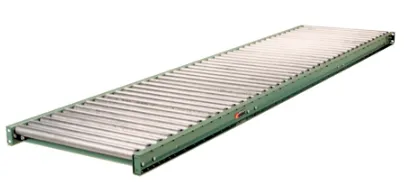At A Plus Warehouse we stock many different types of conveyors, two of which being power and gravity. Though they are very similar and serve the same purpose, they have differences to be aware of. Having this knowledge helps you to make the economically smart choice of product based on your application.
A gravity conveyor is an unpowered conveyor that moves items down a created pathway. The force moving the items in this case is the basic gravitational force or a gravity chute. Usually the conveyors are titled downward to keep the momentum of the moving object. A gravity conveyor will move an item, typically a heavier one, along a pathway without assistance. Usually it is an incline conveyor if you choose a gravity conveyor. Overall these sorts of conveyors are created to take the physical strain and stress off workers and employees and instead pass the heavy lifting and transporting to the conveyor. This does not only eliminate risk of physical harm or pain from moving large object, but it can also create a more efficient work environment. When a machine can do the strenuous work, the worker will have more time to do other more important tasks.

A power conveyor works with a powered device that moves material along a conveyor line. An external power source is required with these sorts of conveyors. A power conveyor is typically a roller conveyor, and in other words is also referred to as a live conveyor. These conveyors may be powered by a belt or chain, depending upon application. Typically, these conveyors are more expensive, need more care with application, and have higher capacities. This is the product you would choose for those more industrial applications.
What is the difference between a belt and chain conveyor?
A chain conveyor is great for product accumulation, the constant addition of products to a conveyor line until they can be packaged. They have less frictions than belts, so they are best for accumulation. Chains are more flexible so when working with curves and other semi irregular shapes a chain is better. Chain conveyors tend to carry heavier loads and deal with large mass flows better. Whereas a belt differs, it is less flexible and has a tighter tension, which means it has a much larger accuracy. When you have small and delicate items you would want high accuracy because it minimized damaged of transfer from one belt to another. They can also move at higher speeds, while still maintaining the same level of precision.
Whether you came to learn about different conveyor types, different powered conveyors, or just to find the right conveyor for you, A Plus Warehouse has an endless supply of conveyors for you. View them on our conveyor landing page below.
Check out our Conveyors!
